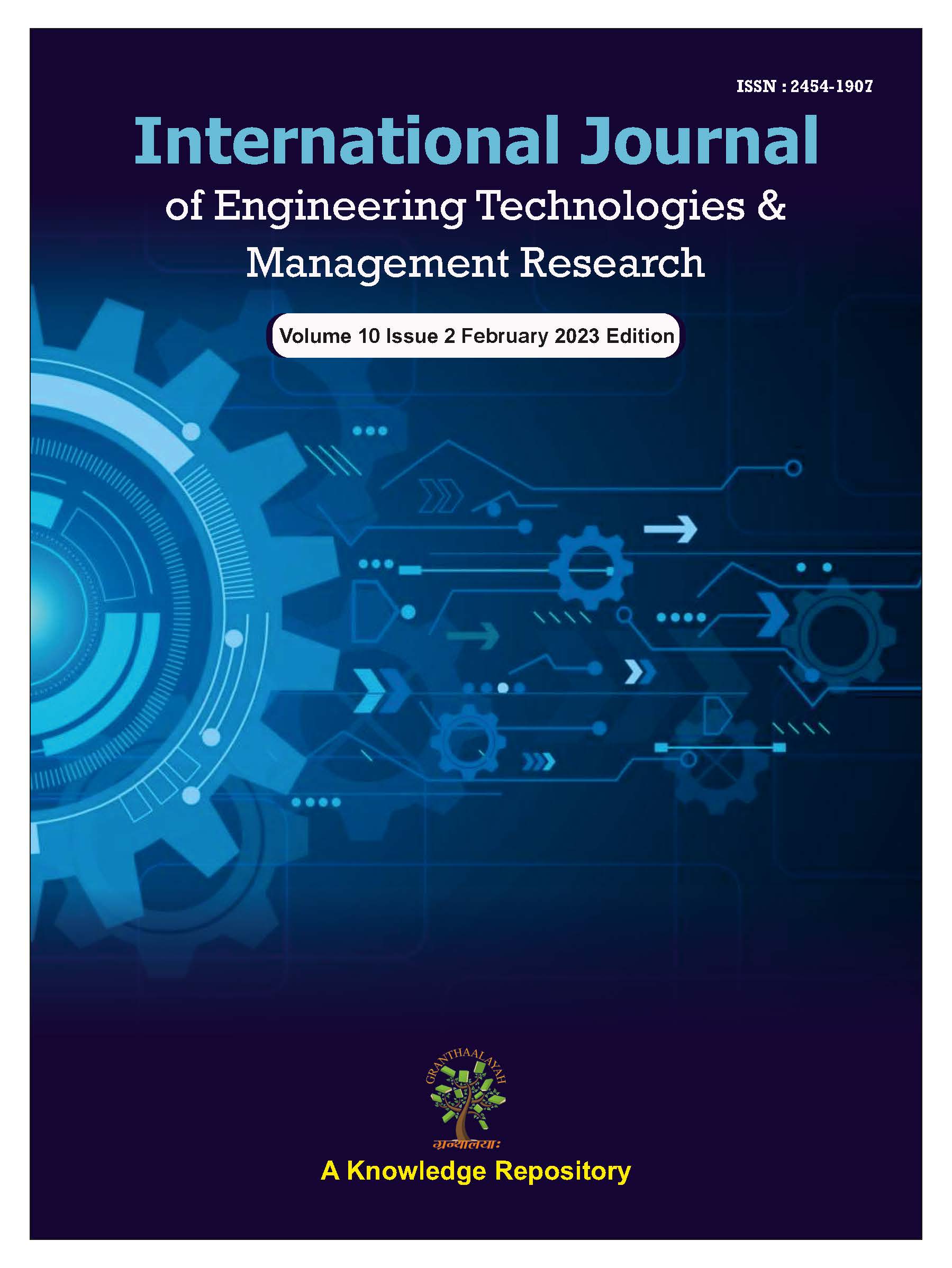DESIGN AND IMPLEMENTATION OF AN INFRARED MOTION DETECTION AND GESTURE CLASSIFICATION SYSTEM USING KALMAN FILTERING AND CONVOLUTIONAL NEURAL NETWORKS
DOI:
https://doi.org/10.29121/ijetmr.v10.i2.2023.1596Keywords:
Implementation, Detection, Motion, Gesture, Infrared, Classification System, Kalman Filtering, Neural NetworksAbstract
This project report presents the design, development, and implementation of an Infrared Motion Detector and an advanced gesture classification system utilizing Kalman filtering and Convolutional Neural Networks (CNNs). The primary objective is to create a cost-effective, efficient, and reliable system capable of detecting motion and accurately classifying dynamic hand gestures for a wide range of applications, including security systems, smart home automation, and human-computer interaction.
The motion detection component is based on the principle of Passive Infrared (PIR) sensing, where the device detects infrared radiation naturally emitted by living beings. When a moving object enters the monitored zone, the sensor captures sudden changes in infrared levels, prompting an appropriate system response, such as activating an alarm or switching on a light. Detailed exploration of the PIR sensor's working mechanism, internal structure, signal processing, and sensitivity calibration is provided.
For gesture classification, the system integrates Kalman filtering to track the motion trajectory and eliminate noise from sensor inputs, ensuring smoother and more accurate prediction of hand movement paths. These filtered motion signals are then processed by a Convolutional Neural Network, trained to recognize a variety of hand gestures with high precision. The CNN automatically extracts spatial and temporal features from the input data, allowing for robust classification even under varying lighting and environmental conditions.
In conclusion, this project not only showcases the practical implementation of infrared-based motion detection but also demonstrates the power of combining predictive filtering and deep learning techniques for sophisticated gesture recognition. The developed system offers a scalable platform for future innovations in smart interfaces, automation, and security technologies, highlighting the growing significance of sensor-driven and AI-enhanced solutions in modern electronics.
Downloads
References
Adams, P. (2021). Motion Detection Systems for Smart Homes. Home Automation Review, 5(2), 52-60.
Carter, T., & Nelson, H. (2020). Hands-on learning in Embedded Systems Design. Advanced Embedded Systems, 27(6), 100-108.
Clark, P., & Norris, R. (2021). Motion-Based Lighting and Climate Control for Green Energy Systems. Environmental Energy Solutions, 4(1), 11-20.
Green, F., & Miller, D. (2020). Passive Infrared Technology: Benefits and limitations. Smart Technology Journal, 8(2), 39-49.
Gupta, R., & Sharma, P. (2020). Cost-Effective Motion Detection Using PIR Sensors. International Journal of Embedded Systems, 15(4), 22-30.
Harris, T., & Young, P. (2020). Miniaturization of PIR Sensors in Wearable Devices. International Journal of Wearable Technology, 3(2), 44-53.
Johnson, K., & Kim, W. (2021). Non-Intrusive Motion Detection Using PIR Sensors. Sensors and Actuators A: Physical, 210, 45-55.
Johnson, T., & Patel, R. (2020). Applications of Motion Detection in Security and Automation. IEEE Transactions on Industrial Electronics, 67(8), 2123-2132.
Khan, F., & Roberts, E. (2019). Challenges in High-End Security and Automation System Installation. Technological Systems Review, 14(2), 67-75.
Lee, A., & Zhang, L. (2020). The Role of Motion Detectors in Home Security Systems. Security Engineering Journal, 8(4), 31-40.
Lee, C., & Chang, M. (2019). Passive Infrared Sensors in Automation Systems. IEEE Sensors Journal, 24(5), 1156-1165.
Liu, J., & Wu, H. (2022). PIR Sensors in IoT Ecosystems: An Integration Perspective. IEEE IoT Journal, 9(3), 85-92.
Miller, B. (2021). The Practical Application of Electronic Circuit Design in PIR Motion Detectors. Journal of Electronics Engineering, 19(4), 111-120.
Miller, S., & Thompson, G. (2022). Healthcare Applications of Motion Detection for Patient Safety. Journal of Healthcare Technology, 12(5), 34-42.
Moore, L., & Evans, D. (2022). Wireless Communication Protocols for PIR Sensors in Smart Environments. Wireless Communication Technologies, 7(1), 22-31.
Parker, G. (2021). Energy Conservation in Home Automation Systems. Journal of Green Technology, 13(2), 45-55.
Patel, N., & Shah, V. (2020). Efficiency Gains Through Real-Time Motion Detection. International Journal of Automation, 22(5), 18-27.
Rivera, J., & Ghosh, S. (2021). Low-Cost Motion Detection Solutions for Everyday use. Technology in Daily Life Journal, 9(1), 25-33.
Roberts, L., & Walker, F. (2020). Impact of Motion Detection Systems in Modern Electronics. Journal of Modern Electronics, 17(4), 10-18.
Robinson, J., & Park, M. (2021). Hybrid Motion Detection Systems with AI and Image Recognition. Journal of Artificial Intelligence Research, 28(6), 58-67.
Singh, H., & Kumar, S. (2020). Comparison of Infrared Motion Detection with Other Techniques. Journal of Sensor Networks, 18(1), 10-20.
Smith, J., & Brown, A. (2022). Automation and the Rise of Intelligent Systems. Journal of Technological Advancements, 15(3), 34-45.
Tan, Z., & Lee, Y. (2022). Implementation of PIR-Based Motion Detection for Lighting Systems. Energy Efficiency Journal, 6(3), 110-119.
Turner, A., & Lee, D. (2020). Energy Savings in Urban Infrastructures Through Motion-Triggered Lighting. Sustainable Urban Development Journal, 6(3), 40-48.
Turner, S., & Davies, J. (2019). Prototyping Low-Cost Motion Detection Systems for Smart Homes. IEEE Transactions on Automation and Control, 31(2), 129-137.
Wang, R., & Huang, C. (2020). Energy-Efficient Motion Sensors for Continuous use. Journal of Sustainable Electronics, 11(4), 68-77.
Wang, Y., & Zhou, T. (2021). Design of a Pir-Based Motion Detection System for Security Applications. Journal of Electronics and Communication Engineering, 45(3), 55-64.
Williams, A. (2021). Infrared Radiation and its Applications in Motion Detection. International Journal of Environmental Sensors, 12(4), 90-100.
Williams, M., & Kim, D. (2021). The Demand for Smart Living Solutions in Urban Areas. Smart City Development Journal, 7(3), 53-62.
Wright, P., & Cooper, T. (2020). Developing Infrared Motion Detection Circuits for IoT. IEEE Journal on IoT Systems, 5(6), 131-140.
Zhang, H., & Chen, X. (2022). Applications of PIR Sensors in Smart Homes and Healthcare. Journal of Ambient Intelligence and Smart Environments, 13(2), 124-132.
Zhao, L., & Liu, X. (2022). The Role of PIR Sensors in 24/7 Security Surveillance. Security and Privacy, 10(1), 7-16.
Published
How to Cite
Issue
Section
License
Copyright (c) 2023 Nancy Singh, Bhanu Pratap, Arvind Kumar, Aditi Kumari, Shefali Madan

This work is licensed under a Creative Commons Attribution 4.0 International License.
License and Copyright Agreement
In submitting the manuscript to the journal, the authors certify that:
- They are authorized by their co-authors to enter into these arrangements.
- The work described has not been formally published before, except in the form of an abstract or as part of a published lecture, review, thesis, or overlay journal.
- That it is not under consideration for publication elsewhere.
- That its release has been approved by all the author(s) and by the responsible authorities – tacitly or explicitly – of the institutes where the work has been carried out.
- They secure the right to reproduce any material that has already been published or copyrighted elsewhere.
- They agree to the following license and copyright agreement.
Copyright
Authors who publish with International Journal of Engineering Technologies and Management Research agree to the following terms:
- Authors retain copyright and grant the journal right of first publication with the work simultaneously licensed under a Creative Commons Attribution License (CC BY-SA 4.0) that allows others to share the work with an acknowledgment of the work's authorship and initial publication in this journal.
- Authors can enter into separate, additional contractual arrangements for the non-exclusive distribution of the journal's published version of the work (e.g., post it to an institutional repository or edit it in a book), with an acknowledgment of its initial publication in this journal.
- Authors are permitted and encouraged to post their work online (e.g., in institutional repositories or on their website) before and during the submission process, as it can lead to productive exchanges, as well as earlier and greater citation of published work.
For More info, please visit CopyRight Section






















